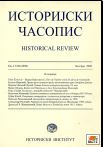Рудник Жежна и рударство Рогозне и Подбуковика у 16. веку
The Žežna Mine and Mining of Rogozna and Podbukovik in the XVI Century
Author(s): Tatjana Katić, Srđan KatićSubject(s): History
Published by: Istorijski institut, Beograd
Keywords: Ottoman Empire; mining; Rogozna; Žežna; mine; silver; hâs; lease; XVI century
Summary/Abstract: Rogozna Mountain and the area of Podbukovik are located in the south of Serbia, between Ibar and Raška rivers. In this area an extremely large number of old mining works remains were found. During the Serbian medieval state, only a few written records of mining in Rogozna from the 14th century were preserved. The works were not of a large scale and seemed to have been suspended by the 15th century. Even after the Ottoman conquest in the mid 15th century there was no mining activity, all until 1516 when a new silver mine Žežna at Mount Rogozna was first mentioned. The mine’s name was often mistakenly read as Drina, Lozna, Serserne in historiography, or it was mixed with a similar title Ržana mine, whose location was also not known. This paper shows that the Žežna and Ržana were two mines, of which the first one was located on the eastern slopes of Rogozna Mountain, and the other one in the southern parts of Kopaonik Mountain. The formation of the Žežna mine’s işçi hâs, with about 20 villages, is presented. These villages later formed the Žežna nâhiye too. Based on the Ottoman financial sources, it was revealed that another four smaller mines on Mount Rogozna belonged to the Žežna mine, as follows: Leskova Glava, Crnac, Kaluder and Strmelj. During mid-16th century in Podbukovik area, three more mines were opened: Orahovo, Lukovo and Lipovica. They also belonged to the Žežna mine and a new işçi hâs was created around them. The analysis of the eight mine locations determined that they are precisely at the places where the most numerous remains of ancient mining were preserved. By comparison with the modern geological research, it can also be concluded that the mines were opened on all lead-zinc-rich deposits in mentioned areas. During the twenties and thirties of the 16th century, annual silver production at the Žežna mine was more than a ton, while in the next period was usually between 300 and 500 kilograms. It was noted that in the mines and the Žežna hâslar the number of Muslims was unusally low. Until the seventies of the 16th century, Christians were the tenants and members of the mining administration. Only later, Muslims tend to take over the leases, while mining administration became religiously mixed. Žežna nâhiye administratively belonged to Prizren sancak, in the judicial terms was the responsibility of the Brvenik kâdî, while mining operations were under the supervision of the Skopje nezâret. The Žežna mine had successfully operated till Vienna War (1683- 1699), during which the Rogozna and Podbukovik mining production was permanently suspended.
Journal: Историјски часопис
- Issue Year: 2010
- Issue No: 59
- Page Range: 197-224
- Page Count: 28
- Language: Serbian

